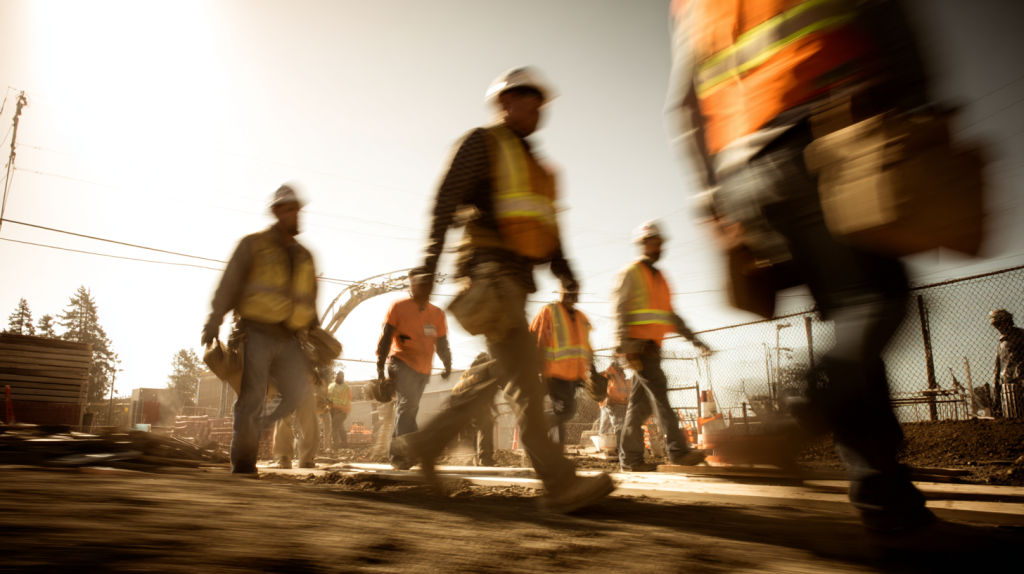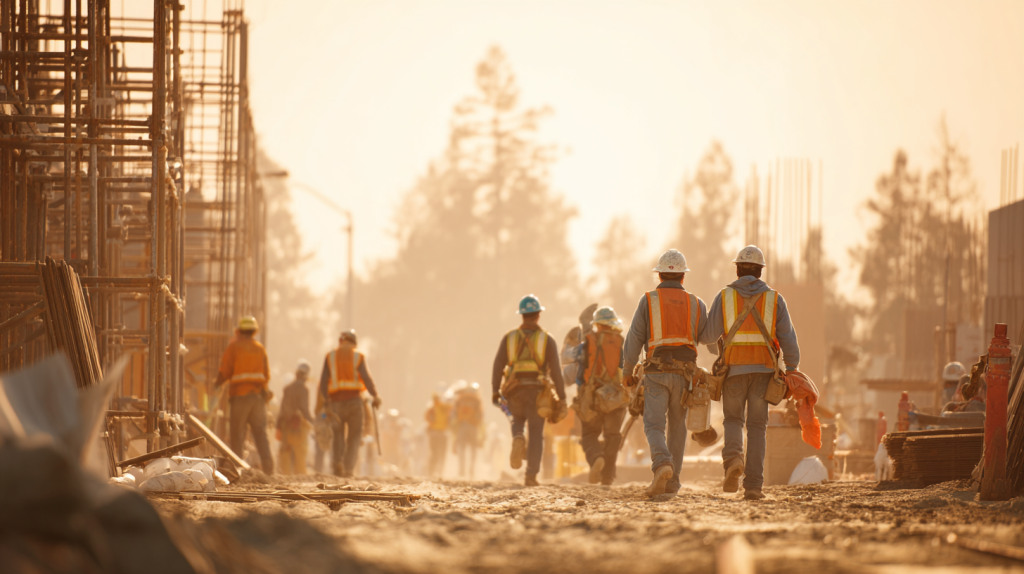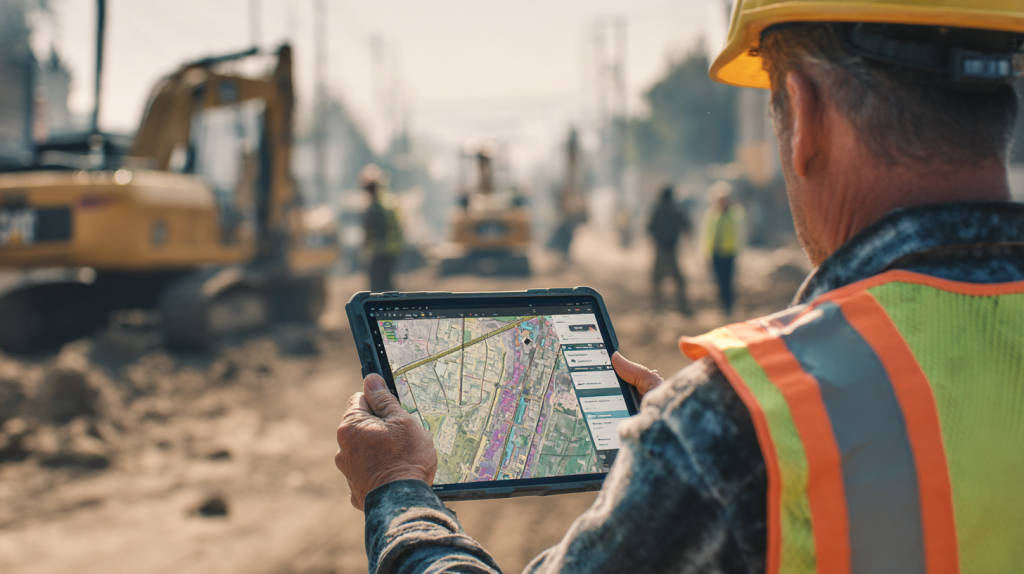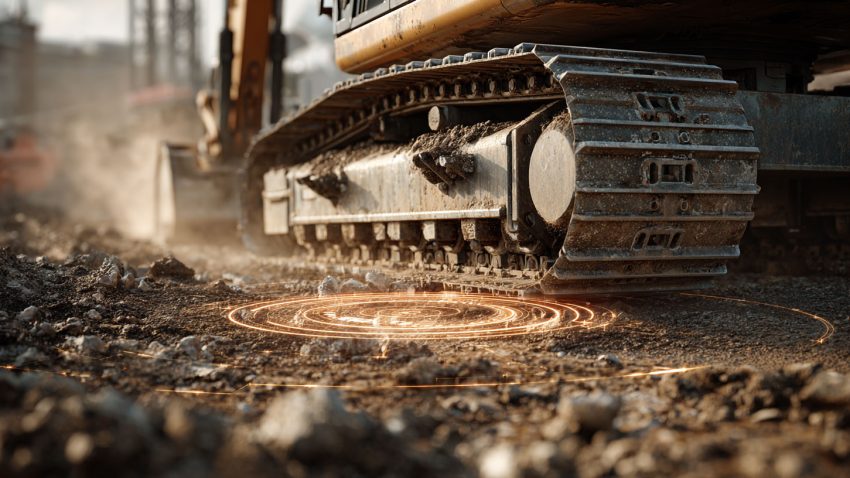How a Construction Logistics Plan (CLP) Helps Superintendents and Contractors Manage Deliveries and Prevent Gate Delays on Busy Jobsites
Table of Contents:

On large, high-traffic construction projects, logistics planning can make or break productivity. Every day, dozens of trucks, cranes, and crews compete for limited space and time at the jobsite gates. Without structure, deliveries pile up, access roads clog, and critical materials arrive late—or worse, not at all. That’s where a Construction Logistics Plan (CLP) becomes indispensable.
A CLP maps out the flow of materials, equipment, and vehicles into and out of the site. It defines delivery schedules, entry and exit routes, laydown zones, and communication protocols so that every movement happens efficiently and safely. For superintendents and general contractors, it’s the operational backbone that prevents gate congestion and ensures smooth coordination between field teams and suppliers.
Modern CLPs are no longer just spreadsheets or PDFs—they’re dynamic, data-driven systems that adapt to changing field conditions. With tools like StruxHub Construction Management Software, superintendents can track live deliveries, automate booking slots, and visualize logistics activity through interactive dashboards. The result is a controlled jobsite where deliveries flow seamlessly, crews stay productive, and safety never takes a back seat.
Why Every Busy Jobsite Needs a Construction Logistics Plan
Without a solid CLP, even the best-run construction teams can face chaos at the gate. Multiple deliveries arriving simultaneously, uncoordinated equipment movement, and restricted access roads can create significant delays and safety risks. A logistics plan eliminates these uncertainties by clearly defining who arrives when, how materials are received, and where they’ll go once on-site.
For superintendents, a CLP acts as both a preventive and predictive tool. It provides a centralized reference for daily coordination meetings and enables smarter scheduling decisions that keep operations flowing. For owners, it demonstrates control, professionalism, and a commitment to maintaining safety and efficiency—even in the most congested urban environments.
H3 Top Benefits
- Prevents traffic bottlenecks at site entrances
- Coordinates multiple deliveries efficiently across trades
- Improves project scheduling and material availability
H3 Best Practices
- Develop the CLP before mobilization begins
- Assign a logistics coordinator to manage daily implementation
- Review and adjust delivery schedules weekly based on site conditions
H3 Q&A Mini-FAQ
Q: What happens if there’s no logistics plan in place?
A: Deliveries overlap, vehicles queue at the gate, and work often halts waiting for materials.
Q: Who should manage the CLP on-site?
A: Typically, the superintendent oversees it with support from logistics or site coordinators.
Q: How often should a CLP be updated?
A: At least weekly, or whenever site layout or delivery needs change.
Related Links
- Related: Best Guide to Construction Logistics Plans (CLPs): What Owners Want to See Before Work Starts
- Related: How Will the Meta Richland Parish Louisiana AI Data Center Handle Material Deliveries and Jobsite Logistics?
- Related: How Can Geographic Information System (GIS) Dashboards Give Superintendents Real-Time Jobsite Visibility?
A well-structured CLP is the difference between chaos and control. It ensures deliveries arrive at the right place, at the right time, without slowing down the flow of work.

Coordinating Deliveries Across Multiple Trades
Large jobsites often involve dozens of subcontractors, each with unique material needs and delivery schedules. Without centralized coordination, conflicts are inevitable. A good CLP ensures that deliveries for different trades are staggered to avoid congestion and overlap. It helps superintendents visualize when and where each trade will need access, preventing crews from tripping over each other—or fighting for crane time.
Centralizing delivery information also allows for more precise planning of laydown areas and storage zones. Using a digital CLP, teams can allocate specific slots for high-priority deliveries and adjust them dynamically when weather or project conditions shift. This level of visibility keeps every trade accountable and helps the superintendent maintain tight control of the site’s logistical flow.
H3 Top Benefits
- Prevents conflicts between subcontractor deliveries
- Enables just-in-time material flow to minimize storage congestion
- Reduces idle time for cranes, trucks, and crews
H3 Best Practices
- Require subcontractors to book delivery slots in advance
- Review the weekly logistics plan in coordination meetings
- Track deliveries using digital dashboards to identify delays early
H3 Q&A Mini-FAQ
Q: Why is delivery coordination so challenging?
A: Multiple trades often share limited space, making timing and communication critical.
Q: How does technology improve delivery scheduling?
A: Platforms like StruxHub allow subs to reserve gate times and update delivery statuses in real time.
Q: Should delivery schedules be shared with all trades?
A: Yes—transparency helps everyone plan and avoid overlapping operations.
Related Links
- Related: What’s the Difference Between Geographic Information Systems (GIS), BIM, and CAD in Construction Projects?
- Related: The Ultimate Guide to Effective Quality Control in Construction: Top Strategies and Tools for Superintendents
- Product Link: StruxHub Delivery Management Dashboard
Coordinated deliveries turn a busy site into a well-orchestrated operation—keeping materials flowing efficiently while minimizing downtime and frustration for every trade.

Preventing Gate Delays Through Pre-Scheduled Time Slots
Gate delays are one of the most common causes of wasted time on active jobsites. Trucks arrive too early, queue up, or are forced to wait while unloading areas are cleared. A Construction Logistics Plan prevents this by introducing a structured booking system where deliveries are assigned specific time slots.
Digital CLPs powered by platforms like StruxHub allow logistics managers to manage these bookings automatically. When each truck’s arrival is pre-scheduled and communicated, congestion disappears. This system also improves relationships with city officials and neighboring properties by reducing street backups and ensuring smoother access during peak hours.
H3 Top Benefits
- Eliminates truck idling and gate congestion
- Improves predictability for material receiving crews
- Enhances compliance with city traffic and delivery regulations
H3 Best Practices
- Set maximum delivery limits per time slot based on site capacity
- Enforce penalties for missed or unscheduled deliveries
- Use digital notifications to alert crews ahead of truck arrivals
H3 Q&A Mini-FAQ
Q: What’s the main cause of gate congestion?
A: Uncoordinated deliveries and lack of communication between suppliers and site teams.
Q: How do digital CLPs prevent this?
A: They automate booking, tracking, and real-time updates for every truck entering the site.
Q: Does pre-scheduling deliveries slow down flexibility?
A: No—it actually improves it by giving supers full visibility to adjust schedules instantly when needed.
Related Links
- Related: The Ultimate Guide to Effective Time Tracking in Construction: Strategies, Tools, and Real-World Applications
- Related: The Ultimate Guide to Change Order Management in Construction: Top Strategies, Tools, and Applications
- Product Link: StruxHub Gate and Delivery Scheduling System
When deliveries arrive on schedule, productivity stays high, safety risks drop, and the entire site runs with clockwork precision—just as a modern logistics plan intends.
Improving Jobsite Safety Through Organized Logistics
Gate congestion isn’t just a productivity issue—it’s a safety risk. Crowded access points and overlapping truck movements create opportunities for accidents, particularly when workers and vehicles share tight spaces. A well-designed Construction Logistics Plan directly addresses this risk by organizing deliveries, staging zones, and vehicle routes to minimize potential conflicts.
Superintendents use the CLP to define traffic flow patterns and safety buffers for loading and unloading areas. It also helps crews anticipate high-traffic periods and coordinate flaggers or spotters accordingly. When deliveries are staggered and routes are clearly marked, the jobsite runs smoother—and safer—for everyone involved.
H3 Top Benefits
- Reduces vehicle-to-pedestrian incidents through controlled routes
- Keeps access points clear and predictable
- Enhances visibility and communication between drivers and field teams
H3 Best Practices
- Include safety officers in logistics planning meetings
- Post updated CLP maps at gate entrances and crew break areas
- Use digital alerts to warn teams when large vehicles are en route
H3 Q&A Mini-FAQ
Q: How can logistics planning reduce safety incidents?
A: It organizes site movement patterns to keep workers clear of heavy traffic zones.
Q: Who should review the CLP for safety compliance?
A: Safety managers and superintendents should collaborate to ensure layouts meet OSHA and company standards.
Q: Can software automate safety alerts for deliveries?
A: Yes—StruxHub can send real-time notifications to crews when trucks are approaching specific gates.
Related Links
- Related: Best Guide to Geographic Information Systems (GIS) in Construction: How Location-Based Data Improves Construction Project Management
- Related: Best Guide to Construction Risk Management: How Top Contractors Control Jobsite Risk
- Product Link: StruxHub Safety and Compliance Module
When safety and logistics are integrated into one coordinated plan, superintendents can move deliveries safely and confidently—without sacrificing speed or efficiency.

StruxHub
Experience the power of StruxHub today and witness firsthand how it can revolutionize your construction operations.
Using CLPs to Design Smarter Traffic Flow and Delivery Routes
The most effective CLPs act as traffic blueprints, showing how vehicles enter, circulate, and exit the site. When routes are pre-mapped and deliveries are time-blocked, trucks don’t stack up at the gates or block active work areas. Strategic traffic design also keeps emergency lanes and pedestrian walkways clear—ensuring safety without disrupting operations.
AI-enabled logistics platforms like StruxHub Construction Management Software take this even further by using predictive analytics to model route conflicts and suggest alternate entry points. This helps supers adjust plans dynamically when congestion or off-site delays occur, keeping the entire supply chain responsive and fluid.
H3 Top Benefits
- Reduces off-site traffic congestion and community impact
- Keeps vehicle circulation predictable and efficient
- Helps maintain compliance with city or DOT logistics requirements
H3 Best Practices
- Design separate entry routes for light and heavy vehicles
- Review local traffic restrictions before setting delivery schedules
- Use digital maps to share routes with drivers and subcontractors
H3 Q&A Mini-FAQ
Q: How can AI improve routing in construction logistics?
A: AI predicts traffic conditions and suggests alternate routes to prevent bottlenecks.
Q: Should traffic routes be reviewed daily?
A: Yes—daily review keeps routes aligned with evolving site layouts and nearby construction activity.
Q: What’s the best way to communicate route changes?
A: Use StruxHub’s delivery dashboard to broadcast live updates to all scheduled drivers.
Related Links
- Related: Best Guide to Construction Risk Management: How Top Contractors Control Jobsite Risk and Improve Field Accountability
- Related: Best Software to Track Construction Material Deliveries, Inventory, and Jobsite Usage
- Product Link: StruxHub Traffic and Gate Coordination Tools
Strategic traffic planning prevents delivery gridlock while keeping jobsite access safe, clear, and compliant—allowing crews to focus on progress instead of parking.
Transitioning from Manual to Digital Construction Logistics Plans
The days of managing deliveries through whiteboards, spreadsheets, and phone calls are long gone. Digital Construction Logistics Plans bring visibility, accountability, and automation to a process that once depended on luck and constant supervision. Platforms like StruxHub digitize every part of the CLP, from delivery booking to live vehicle tracking, allowing superintendents to manage logistics in real time.
Digital CLPs also eliminate miscommunication between trades and suppliers. Instead of paper maps or outdated gate schedules, everyone accesses the same up-to-date plan on their mobile devices. The result is a seamless workflow where information moves as fast as the trucks themselves—no more surprises at the gate.
H3 Top Benefits
- Automates booking, scheduling, and delivery tracking
- Eliminates manual data entry and communication errors
- Keeps logistics plans updated across all stakeholders in real time
H3 Best Practices
- Train all subcontractors and suppliers to use the digital platform
- Assign one logistics lead to oversee updates and communication
- Use analytics reports to identify recurring delays or bottlenecks
H3 Q&A Mini-FAQ
Q: How do digital CLPs improve coordination?
A: They give everyone live access to delivery and gate schedules in one place.
Q: Is the transition from paper to digital difficult?
A: Not at all—platforms like StruxHub offer simple interfaces and require minimal training.
Q: Can digital CLPs integrate with project schedules?
A: Yes—they sync directly with project management software, ensuring logistics align with the master schedule.
Related Links
- Related: The Best Guide to AI and Robotics in Construction: Boosting Efficiency and Safety with Advanced Management Software
- Related: Foreman’s Best Guide to Construction Site Management: Top 10 Tips for Supervising Crews and Productivity
- Product Link: StruxHub Logistics and Scheduling Platform
Moving from manual to digital logistics planning gives superintendents a command-center view of the jobsite—making every delivery predictable, traceable, and right on time.
StruxHub
Discover how StruxHub can revolutionize your construction management. Contact us today!
How StruxHub Helps Superintendents Prevent Gate Delays
StruxHub was built to solve one of construction’s most frustrating problems—gate congestion and uncoordinated deliveries. The platform combines scheduling, routing, and communication tools that give superintendents total control over site logistics. Using AI-powered scheduling, StruxHub can predict busy delivery periods and automatically balance time slots across trades to prevent overlap.
Superintendents can manage bookings directly from their mobile devices, view live delivery statuses, and adjust time slots on the fly. Owners benefit from complete transparency, with dashboards that visualize real-time jobsite activity. StruxHub also sends automated alerts to crews and suppliers, ensuring trucks arrive only when the site is ready to receive them.
This data-driven approach turns chaos into order, helping contractors maintain workflow, safety, and accountability from the first truck to the last delivery.
H3 Top Benefits
- Automates delivery scheduling to prevent gate congestion
- Provides real-time delivery tracking and notifications
- Synchronizes logistics with project schedules for seamless coordination
H3 Best Practices
- Review daily gate schedules each morning in StruxHub
- Assign digital booking access to all subcontractors
- Use analytics to identify recurring suppliers or trades causing delays
H3 Q&A Mini-FAQ
Q: Does StruxHub replace manual gate logs?
A: Yes—it digitizes every gate transaction, creating a live, verifiable record of all site activity.
Q: How does StruxHub reduce downtime for crews?
A: Deliveries arrive only when space and labor are ready, minimizing idle time.
Q: Can StruxHub manage multiple gates on the same project?
A: Absolutely—its dashboard allows supers to coordinate and monitor each access point in real time.
Related Links
- Related: Superintendent’s Best Guide to Effective Daily Reports: Top 10 Tips for Smarter Construction Project Management
- Related: The Best Guide to Delivery Management Systems (DMS) for Commercial Construction
- Product Link: StruxHub Delivery Management and Gate Scheduling System
StruxHub replaces uncertainty with control—turning delivery scheduling into an intelligent, automated system that keeps busy jobsites organized and efficient.

FAQ
What is a Construction Logistics Plan (CLP)?
A Construction Logistics Plan is a strategic document outlining how materials, vehicles, and equipment move into, through, and out of a construction site. It includes delivery schedules, access routes, staging zones, and coordination procedures to prevent congestion and improve efficiency. A CLP serves as both a planning and management tool that ensures daily operations remain predictable, safe, and aligned with project schedules.
Why are CLPs essential for busy jobsites?
Busy jobsites see constant movement between trades, suppliers, and equipment operators. Without a logistics plan, deliveries clash, traffic backs up, and crews waste hours waiting for access. CLPs eliminate these inefficiencies by pre-scheduling deliveries, organizing routes, and designating specific areas for loading and storage. The result is smoother workflows, reduced risk, and higher productivity across all project phases.
How do digital CLPs help superintendents and contractors?
Digital CLPs like StruxHub’s transform static plans into real-time logistics systems. They automate scheduling, track vehicle movements, and synchronize updates with project schedules. Superintendents can monitor deliveries from mobile devices, adjust slots instantly, and notify crews before trucks arrive. These features save time, reduce confusion, and prevent bottlenecks at busy gates.
Can a CLP improve safety compliance?
Yes. By structuring vehicle routes and delivery zones, CLPs separate workers from heavy traffic areas and reduce accident risk. They also integrate safety zones and alert systems that notify teams when deliveries are approaching. Digital platforms take this further by logging safety-related incidents automatically, providing documentation for compliance and audits.
How does StruxHub enhance Construction Logistics Plans?
StruxHub automates every phase of logistics management—from booking to delivery tracking. Its AI-driven platform predicts congestion, optimizes routes, and provides live dashboards for superintendents and owners. With integrated safety and scheduling tools, StruxHub keeps teams informed, deliveries on time, and gates clear—all while maintaining full visibility across multiple projects.

StruxHub
Discover how StruxHub can revolutionize your construction management. Contact us today!
Related Pillar Articles:
Best Guide to Construction Logistics Plans (CLPs): What Owners Want to See Before Work Starts



